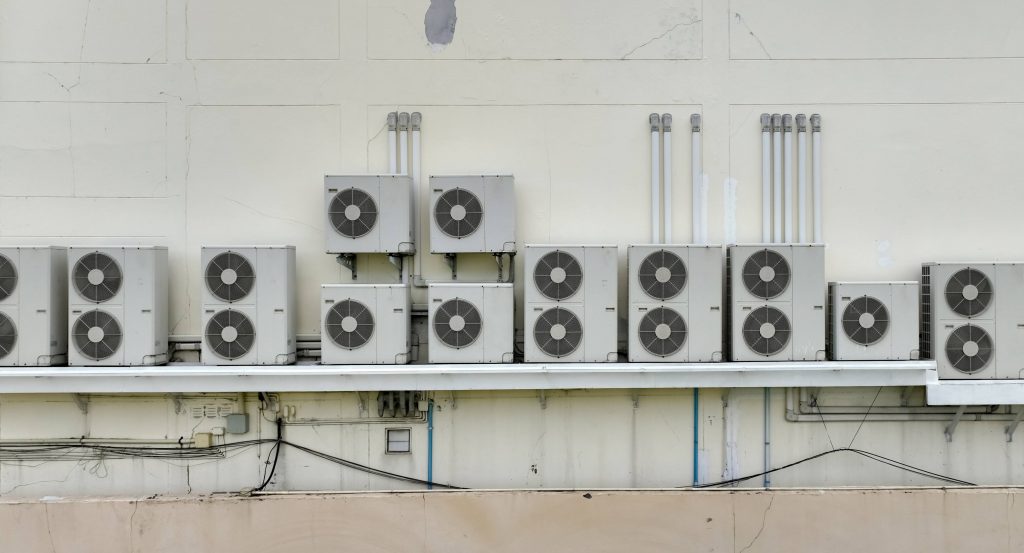
With the summer heat blazing outside, your AC unit, including the condensing unit, condensing coil, and condensing fan motor, becomes your best friend in keeping your indoor space cool and comfortable. However, an often-overlooked maintenance task is ensuring that your AC condensate drain line, pipe, tray, and even the unit’s condensate pump remain clear of any clogs. A clogged condensate drain line can cause water leakage, reduced cooling efficiency, and potential damage to your system. Fortunately, unclogging the drain line is a relatively simple task that can be done with a few basic tools and a little patience. In this blog, we’ll walk you through a step-by-step guide on how to unclog a clogged AC condensate drain line and maintain a properly functioning AC unit.
Step 1: Turn Off the Power:
Before you begin any work on your air conditioning system, it’s crucial to ensure your safety. Locate your AC unit’s circuit breaker and switch off the power supply to the condensing unit and its components. This will prevent any accidental electrical shocks while working on the condensate drain line.
Step 2: Locate the AC Condensate Drain Line, Pipe, and Tray:
The AC condensate drain line is usually a PVC pipe located near the indoor air handling unit or the furnace. It is typically white or gray in color and has a T-shaped fitting with a capped end. Additionally, locate the AC condensate pipe and tray, which may be connected to the condensing unit. Familiarize yourself with these components before proceeding.
Step 3: Inspect for Clogs:
Using a flashlight, inspect the AC condensate drain line, pipe, and tray for any visible clogs. Look for accumulated debris, such as dust, dirt, algae, or mold. These can often be seen near the openings of the drain line, pipe, or inside the tray. If you can see a blockage, proceed to the next step.
Step 4: Clear the Clog in the AC Condensate Drain Line:
To clear the clog in the AC condensate drain line, you can use one of the following methods:
a. Using a Wet/Dry Vacuum: Attach the vacuum to the end of the drain line or directly over the opening. Create a tight seal around the opening to maximize suction power. Turn on the vacuum and allow it to draw out the clog and any trapped water. Repeat the process several times until the line is clear.
b. Flushing with Water: If you don’t have a wet/dry vacuum, you can try flushing the drain line with water. Use a funnel or a small container to pour a mixture of equal parts white vinegar and water into the drain line. The vinegar helps dissolve the clog and inhibits future algae growth. Let the mixture sit in the line for about 30 minutes. Next, flush the line with clean water to remove the dissolved debris. Repeat this process if necessary.
Step 5: Clean the AC Condensate Tray and Components:
While the clog is removed, take the opportunity to clean the AC condensate tray and other components. Use a mixture of mild detergent and warm water to scrub away any accumulated dirt or grime. Rinse the tray thoroughly and dry it before reassembling.
Step 6: Check the AC Condensate Pump (if applicable):
If your AC unit has a condensate pump, inspect it for any clogs or malfunctions. Refer to the manufacturer’s instructions on how to maintain and troubleshoot the pump. Clean or repair as necessary to ensure proper functioning.
Step 7: Reassemble and Test:
Once the AC condensate drain line is clear, the tray is clean, and any issues with the condensate pump are resolved, reassemble the components. Replace the cap on the drain line and ensure it is secured tightly. Restore power to your AC unit and let it run for a while. Check for any leaks around the drain line or the condensing unit. If everything looks good, congratulations! You’ve successfully unclogged your AC condensate drain line and ensured the smooth operation of your AC unit.
Preventative Maintenance Tips:
To minimize the risk of future clogs in the AC condensate drain line and related components, consider the following preventative measures:
Regularly inspect and clean your air filters to prevent dust and debris buildup. Keep the area around the condensate drain line, pipe, tray, and condensing unit clear of any obstructions.
Use a condensate drain line cleaning solution periodically to inhibit algae and mold growth.
Schedule annual professional maintenance for your AC unit, including a thorough inspection of the condensing unit and its components.
To really take care of the situation, try out Brodi’s AC Gel Pucks for maximum treatment. Our industrial grade product prevents slime, sludge and fungus accumulation which can lead to bacteria growth, potentially causing infections.
By following these steps and practicing preventative maintenance, you can keep your AC unit and its condensate system running smoothly throughout the summer months, ensuring optimal cooling efficiency and avoiding potential issues down the road.

